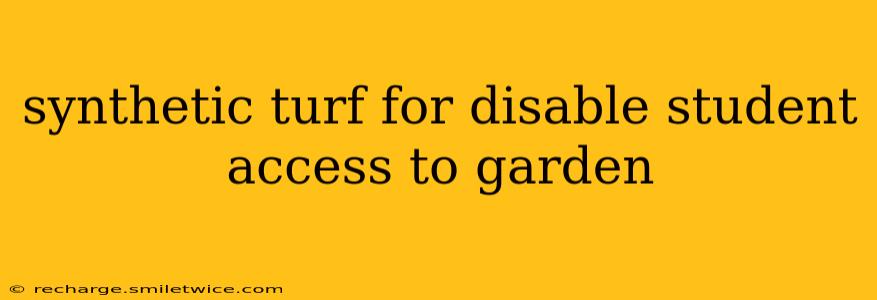Creating inclusive and accessible learning environments is paramount, and for students with disabilities, access to outdoor spaces like gardens can be transformative. However, traditional gardens often present significant barriers. This is where synthetic turf steps in, offering a practical and versatile solution for creating accessible garden spaces for disabled students. This article explores the benefits of synthetic turf in this context, addressing common questions and concerns.
Why Choose Synthetic Turf for Disabled Student Access?
Synthetic turf, or artificial grass, offers numerous advantages over natural grass in creating accessible gardens for students with disabilities. Its smooth, even surface eliminates uneven terrain, tripping hazards, and the challenges posed by mud or wet grass. This ensures safe and independent mobility for wheelchair users and those with mobility impairments. Furthermore, synthetic turf requires significantly less maintenance than natural grass, reducing the need for manual labor and minimizing allergens like pollen.
What are the Benefits of Synthetic Turf in a School Garden?
Beyond accessibility, synthetic turf provides several additional benefits within a school garden setting:
- Improved Drainage: Synthetic turf systems often include excellent drainage, preventing waterlogging and creating a safer, drier environment. This is particularly important for students using wheelchairs or other mobility aids.
- Reduced Maintenance: Less time spent on mowing, weeding, and watering translates to more time for educational activities and student engagement.
- All-Weather Use: Unlike natural grass, synthetic turf remains usable even in wet or inclement weather, extending the opportunities for outdoor learning and activities.
- Increased Durability: Synthetic turf is highly durable and resilient, able to withstand heavy use from students and withstand the wear and tear of wheelchairs and other equipment.
- Enhanced Aesthetics: Modern synthetic turfs are available in a variety of colors and textures, allowing for the creation of visually appealing and engaging garden spaces.
How Can Synthetic Turf Enhance Accessibility Specifically for Disabled Students?
The smooth, even surface of synthetic turf directly addresses several accessibility challenges:
- Wheelchair Accessibility: The flat, firm surface allows for easy wheelchair navigation, eliminating the obstacles presented by uneven terrain, bumps, or soft ground.
- Improved Mobility: Students with other mobility impairments, such as those using walkers or canes, will find the stable surface easier and safer to navigate.
- Reduced Risk of Falls: The even surface minimizes the risk of tripping or falling, contributing to a safer environment for all students.
- Sensory Considerations: Synthetic turf can be chosen with consideration for sensory sensitivities, offering a more predictable and comfortable texture underfoot.
What are the Costs Involved in Installing Synthetic Turf for a School Garden?
The cost of installing synthetic turf varies depending on factors such as the size of the area, the type of turf chosen, and the labor costs. However, it's important to consider the long-term cost savings associated with reduced maintenance requirements compared to natural grass. Many schools find that the initial investment is offset by the long-term benefits. Investigating local installers and obtaining multiple quotes is crucial for determining the exact cost.
Are There Any Environmental Considerations with Synthetic Turf?
While synthetic turf has many advantages, environmental considerations, like the production of the material and potential microplastic runoff, should be carefully evaluated. Choosing a high-quality, environmentally friendly synthetic turf, and properly managing its end-of-life disposal, are vital steps to minimize environmental impact.
What are the Maintenance Requirements for Synthetic Turf in a School Garden Setting?
Synthetic turf requires minimal maintenance. Regular brushing to remove debris and occasional cleaning to remove stains are typically sufficient. This low-maintenance nature contributes significantly to the overall accessibility and ease of use for students and staff.
Conclusion
Synthetic turf offers a compelling solution for creating accessible and engaging garden spaces for disabled students. Its inherent accessibility features, combined with low maintenance and durability, create an inclusive learning environment that fosters independence, learning, and enjoyment of the outdoors. By carefully considering the initial investment, maintenance, and environmental factors, schools can create a welcoming and enriching outdoor space for all their students.
